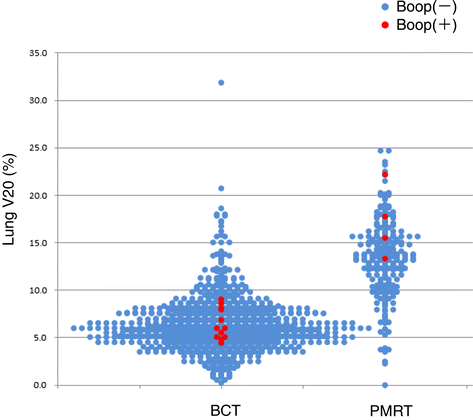Radiation-induced bronchiolitis obliterans organizing pneumonia (BOOP) syndrome in breast cancer patients is associated with age
- PMID: 25924810
- PMCID: PMC4415292
- DOI: 10.1186/s13014-015-0393-9
Radiation-induced bronchiolitis obliterans organizing pneumonia (BOOP) syndrome in breast cancer patients is associated with age
Abstract
Background: Radiation-induced bronchiolitis obliterans organizing pneumonia (BOOP) syndrome is a rarely observed phenomenon characterized by infiltration of the lungs outside of the radiation field, differentiating it from radiation pneumonitis (RP).The risk factors for radiation-induced BOOP (RT-BOOP) remain unclear and controversial. We retrospectively analyzed the incidence and risk factors for RT-BOOP associated with radiation therapy (RT) after breast conserving surgery (BCS) and post-mastectomy radiation therapy (PMRT).
Methods and materials: We analyzed 1,176 breast cancer patients treated with RT after BCS or PMRT between March 2005 and September2008 at the cancer institute hospital of the Japanese foundation for cancer research. Chest radiographs were routinely obtained every three to six months for at least 12 months after surgery, as well as when the patients experienced respiratory symptoms or fever.
Results: RT-BOOP syndrome was diagnosed in 16patients (1.4%), including12BCS patients (1.3%) and four PMRT patients (1.8%). An older age (≥52 years old) was significantly associated with the incidence of RT-BOOP syndrome in a univariate analysis (p =0.023). The type of treatment (BCS or PMRT) and irradiated lung volume at 20 Gy (V20) were not significantly associated with the incidence of RT-BOOP syndrome in the entire patient cohort. In the multivariate analysis, age and smoking were the significant factor associated with RT-induced BOOP syndrome (p =0.044 and 0.049, respectively).
Conclusions: RT-BOOP syndrome was a rarity, and the incidence for BCT cases was similar to that for PMRT cases. The irradiated lung volume was not significantly associated with RT-BOOP syndrome. An older age can predict the incidence of RT-BOOP syndrome.
Figures



Similar articles
-
Analysis of factors associated with radiation-induced bronchiolitis obliterans organizing pneumonia syndrome after breast-conserving therapy.Int J Radiat Oncol Biol Phys. 2009 Mar 15;73(4):1049-54. doi: 10.1016/j.ijrobp.2008.05.050. Epub 2008 Aug 26. Int J Radiat Oncol Biol Phys. 2009. PMID: 18755559
-
The clinical characteristics and non-steroidal treatment for radiation-induced bronchiolitis obliterans organizing pneumonia syndrome after breast-conserving therapy.Radiother Oncol. 2010 Oct;97(1):95-100. doi: 10.1016/j.radonc.2010.02.032. Epub 2010 Apr 10. Radiother Oncol. 2010. PMID: 20385415
-
A survey of radiation-induced bronchiolitis obliterans organizing pneumonia syndrome after breast-conserving therapy in Japan.Int J Radiat Oncol Biol Phys. 2008 May 1;71(1):123-31. doi: 10.1016/j.ijrobp.2007.09.003. Epub 2007 Dec 3. Int J Radiat Oncol Biol Phys. 2008. PMID: 18060702
-
[Bronchiolitis obliterans organizing pneumonia after irradiation therapy for breast cancer].Nihon Kokyuki Gakkai Zasshi. 2003 Feb;41(2):99-106. Nihon Kokyuki Gakkai Zasshi. 2003. PMID: 12722328 Review. Japanese.
-
[Pulmonary damage after radiotherapy for breast cancer].Ned Tijdschr Geneeskd. 1999 Apr 17;143(16):833-6. Ned Tijdschr Geneeskd. 1999. PMID: 10347650 Review. Dutch.
Cited by
-
Breast radiotherapy in elderly women: myths, controversies, and current techniques in the adjuvant setting.Transl Cancer Res. 2020 Jan;9(Suppl 1):S37-S55. doi: 10.21037/tcr.2019.07.09. Transl Cancer Res. 2020. PMID: 35117947 Free PMC article. Review.
-
Incidence of organizing pneumonia after whole-breast radiotherapy for breast cancer, and risk factor analysis.J Radiat Res. 2018 May 1;59(3):298-302. doi: 10.1093/jrr/rry001. J Radiat Res. 2018. PMID: 29415179 Free PMC article.
-
Radiation-induced lung toxicity - cellular and molecular mechanisms of pathogenesis, management, and literature review.Radiat Oncol. 2020 Sep 10;15(1):214. doi: 10.1186/s13014-020-01654-9. Radiat Oncol. 2020. PMID: 32912295 Free PMC article. Review.
-
Incidence and prevalence of interstitial lung diseases worldwide: a systematic literature review.BMJ Open Respir Res. 2023 Jun;10(1):e001291. doi: 10.1136/bmjresp-2022-001291. BMJ Open Respir Res. 2023. PMID: 37308252 Free PMC article.
-
Cryptogenic Organizing Pneumonia: Evolution of Morphological Patterns Assessed by HRCT.Diagnostics (Basel). 2020 Apr 29;10(5):262. doi: 10.3390/diagnostics10050262. Diagnostics (Basel). 2020. PMID: 32365469 Free PMC article.
References
-
- Early Breast Cancer Trialists’ Collaborative Group Favourable and unfavourable effects on long-term survival of radiotherapy for early breast cancer: an over view of the randomized trials. Early breast cancer trialists’ collaborative group. Lancet. 2000;355:1757–70. doi: 10.1016/S0140-6736(00)02263-7. - DOI - PubMed
-
- Whelan TJ, Julian J, Wright J, Jadad AR, Levine ML. Does locoregional radiation therapy improve survival in breast cancer? A meta-analysis. J Clin Oncol. 2000;18:1220–9. - PubMed
-
- Takigawa N, Segawa Y, Saeki T, Kataoka M, Ida M, Kishino D, et al. Bronchiolitis obliterans organizing pneumonia syndrome in breast-conserving therapy for early breast cancer: radiation-induced lung toxicity. Int J Radiat Oncol Biol Phys. 2000;48:751–5. doi: 10.1016/S0360-3016(00)00654-4. - DOI - PubMed
-
- Miwa S, Morita S, Suda S, Suzuki K, Hayakawa H, Chida K, et al. The incidence and clinical characteristics of bronchiolitis obliterans organizing pneumonia syndrome after radiation therapy for breast cancer. Sarcoidosis Vasc Diffuse Lung Dis. 2004;21:212–8. - PubMed
MeSH terms
LinkOut - more resources
Full Text Sources
Other Literature Sources
Medical

